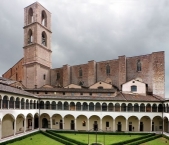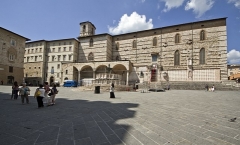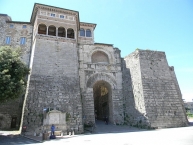Perugia
Worth visiting
Added on 13 Oct 2022,
last edited by biroto-Redaktion on 13 Oct 2022
Nearby cycle routes and tours
| Route name | Type | Dist. to route |
|---|---|---|
Tour | 0,0 km | |
Tour | 0,1 km | |
Tour | 4,1 km |
![]()
Please wait - map data are loading
Type of sights
Old town
Name and address
Perugia
IT-06100 Perugia
GEO-data
Geodetic coordinates
43.11∎∎∎∎ 12.38∎∎∎∎
Elevation
497 m
Communication
Information about copyright | |
|---|---|
Rights owner | https://commons.wikimedia.org/w/index.php?title=User:Maurobifani |
Rights characteristic / license | by-sa: CREATIVE COMMONS Attribution-ShareAlike |
Link to the description of the license | |
Image taken over from | https://commons.wikimedia.org/wiki/File:Sabato_sera_in_piazza_IV_Novembre.jpg |
Image has been uploaded | by biroto-Redaktion on 13 Oct 2022
|
Information about copyright | |
|---|---|
Rights owner | |
Rights characteristic / license | by-sa: CREATIVE COMMONS Attribution-ShareAlike |
Link to the description of the license | |
Image taken over from | https://commons.wikimedia.org/wiki/File:Perugia,_museo_archeologico_nazionale,_chiostro_05,0.jpg |
Image has been uploaded | by biroto-Redaktion on 13 Oct 2022
|
Information about copyright | |
|---|---|
Rights owner | https://web.archive.org/web/20161031200034/www.panoramio.com/user/861544?with_photo_id=121026 |
Rights characteristic / license | by-sa: CREATIVE COMMONS Attribution-ShareAlike |
Link to the description of the license | |
Image taken over from | https://commons.wikimedia.org/wiki/File:Perugia,_Italy_-_panoramio_(51).jpg |
Image has been uploaded | by biroto-Redaktion on 13 Oct 2022
|
Information about copyright | |
|---|---|
Rights owner | https://commons.wikimedia.org/w/index.php?title=User:Bibopg79 |
Rights characteristic / license | by-sa: CREATIVE COMMONS Attribution-ShareAlike |
Link to the description of the license | |
Image taken over from | |
Image has been uploaded | by biroto-Redaktion on 13 Oct 2022
|
Perugia is a city in the Italian region of Umbria. It has an important university that attracts many foreign students, is a major center of medieval art, has a stunningly beautiful central area and is home of the Umbria Jazz Festival. The city is also a major producer of chocolates.
Understand
The hills on which Perugia rises have been inhabited since ancient times. This is evidenced by numerous finds from prehistoric and early historical periods. Between the 6th and 5th centuries BC the area is occupied by the Etruscans, and in the 3rd century BC Perugia is the seat of Lucumonia (king and spiritual leader revered as a deity) and a member of the Etruscan Dodecapolis. Over the next two centuries, the city was alternately allied with Rome and then enemy again, until it fell in 40 BC finally subjugated by Octavian. In the Roman Empire, the city loses importance until it becomes almost an insignificant province. Around the 5th century there are first indications of a Perugia diocese and thus proof of the Christian organization and consolidation of the clergy. The defense of a siege by the Goths Totilas was led by Bishop Ercolano, but his defeat led to his martyrdom (548 AD). The following centuries are marked by changing fortunes, until the city finally falls into the hands of the Church. Around the 11th century, the rise to renewed dominance that lasted two centuries began. Wars against the neighboring cities, which are conquered and subdued, and alliances with the Church and the neighboring states make Perugia one of the most prosperous cities in Italy. In this heyday, however, internal disputes began that overshadowed the entire 15th century (Periodo delle Signorie, epoch of the nobility) and finally ended in 1540 (the Salt War) with the city's submission to church rule. The municipal courts are abolished and replaced by a papal governor, and the papal fortress of Rocca Paolina is built on the ruins of the Baglioni palaces. This situation lasted for more than three centuries until Perugia took part in the Risorgimento (national unification movement) in 1859, rebellion against the papal troops and bloodbaths, on September 14, 1860 the royal troops of Vittorio Emanuele II occupied the city, which from then on shares the changed fate of the Italian state.
See
- ⊙Rocca Paolina. It was a Renaissance fortress, built in 1540-1543 for pope Paul III to designs by Antonio da Sangallo the Younger. The escalators from the lower town lead up through the remains of this fortress. It was built on top of medieval streets, which were used as foundations, and before coming out into daylight at Piazza Italia you go through some of these medieval streets covered with brick ceilings when the fortress was built. Little now remains of the fortress itself. Free admission.
(updated May 2019)
- ⊙Porta Marzia (Marzia Gate). This is an Etruscan city gate built in the 3rd century BC and much later incorporated into the city walls. It is close to the remains of the Paolina Fortress.
- ⊙Arco Etrusco (Etruscan Arch). This is an Etruscan city gate built in the 3rd century BC. With its 11 m. height and because of its excellent state of preservation, it is considered as the most impressive of all the ancient Etruria..
- ⊙Fontana Maggiore. This large medieval fountain is found between the cathedral and the Palazzo dei Priori. It was made between 1277 and 1278 by Nicola and Giovanni Pisano as part of Perugia's celebrations of its independence. On the twenty-five sides of the basin are sculptures representing prophets and saints, the work of the seasons, signs of the zodiac, Bible scenes and events from Roman history.
- ⊙Perugia Cathedral (Cattedrale di San Lorenzo). This has an unusual layout for Italian churches in that the side rather than the front entrance faces the main square. There have been many churches on the site: this one was last worked on around 1490. But finished it was not, as can be clearly seen from the unfinished façade facing the square. This side includes the Loggia di Braccio, an early Renaissance structure. Under it a section of Roman wall and the basement of the old bell tower can be seen. Also found here is the 1264 Pietra della Giustizia ("Justice Stone") with which Perugia announced that it had repaid its public debt, a not inconsiderable feat. Also noteworthy is the external pulpit from which Saint Bernardine of Siena, a virulently anti-homosexual priest, would preach.
- Capitular Museum (Museo del Capitolo della Cattedrale di San Lorenzo), in the cloister of St. Lorenzo Cathedral. Religious paintings.
- Archeologic Area of the Cathedral of San Lorenzo. Tu-Su 11:00 and 15:30. €8. (updated May 2019)
- ⊙Palazzo dei Priori (Town Hall) (Opposite the side of the cathedral, with its main entrance on Corso Vannucci). This is a large building in Italian Gothic style built in the early 1300s. On the side facing the piazza are a griffin, the emblem of Perugia, a 14th-century bronze lion, and some chains, from where the keys of Siena were displayed after victory over the Sienese in 1358. Inside is the impressive meeting room, the Sala dei Notari. On the second floor is the Municipal Library. The building also houses the National Gallery of Umbria.
- Galleria Nazionale dell’Umbria (National Gallery of Umbria) (inside the Palazzo dei Priori). Tu-Sa 08:30-19:30, closed Mondays, 1st January, 1st May, 25 December. €8.
The collection consists of paintings from the 13th to the 19th century, including artists such as Perugino, Nicola e Giovanni Pisano, Beato Angelico, Benozzo Gozzoli, and Pinturicchio. (updated Apr 2019) - Nobile Collegio della Mercanzia (inside the Palazzo dei Priori).
- Nobile Collegio del Cambio, Corso Vannucci, 25 (inside the Palazzo dei Priori). M-Sa 09:00-12:30; 14:30-17:30.
Displays various works of art. €4.50. (updated May 2019)
- Galleria Nazionale dell’Umbria (National Gallery of Umbria) (inside the Palazzo dei Priori). Tu-Sa 08:30-19:30, closed Mondays, 1st January, 1st May, 25 December. €8.
- ⊙Etruscan Well (Pozzo Etrusco), Piazza Danti 18 (To the right, just past the front entrance of the cathedral). 11:00-13:30, 14:30-17:00, longer in the summer months.
Damp and dark but an excellent way of appreciating the skills of 3rd-century BC Etruscan architects. €3. (updated May 2019) - ⊙San Domenico, on Corso Cavour, down the hill to the southeast of Corso Vannucci.
It is a Gothic church whose three aisles were a model for the design of the later cathedral of San Lorenzo. San Domenico has faced many problems in the past. Soon after its completion, the upper section was found to be unstable and had to be demolished. In 1614 and 1615 other parts collapsed. The rebuilt church was consecrated in 1632.
Open: 7:00 am - 12:00 pm 4:00 pm - 7:00 pm, free. (updated Oct 2022) - ⊙San Pietro, Borgo XX Giugno, 74.
About 1 km further along Corso Cavour after San Domenico, this church and abbey is well filled with fine works of art, including by Perugino. Interesting hexagonal bell tower. See too the medieval garden through the hall off the courtyard.
Open: Mo-Sa 10:00 am – 1:00 pm / 2:00 pm – 6:00 pm. €6, €3 reduced.(updated Oct 2022)
Museums
Perugia City Museum Card allows access to any 5 museums of the following 10 ones: San Severo Chapel, National Gallery of Umbria, Volumni Hypogeum, National Archaeological Museum of Umbria, Capitolar Museum, Nobile Collegio del Cambio, Nobile Collegio della Mercanzia, Palazzo Baldeschi al Corso, Museum of Palazzo della Penna, Etruscan Well. It also allows reduced admission to Archeologic Area of the Cathedral of San Lorenzo, Museum of the Academy of fine Arts, Palazzo Sorbello House Museum, Templar Complex of San Bevignate, in addition to discounts at featured restaurants. It's valid for 48 hours and costs €14 for adults and €10 for students (May 2019).
- ⊙Academy of Fine Arts (Accademia di belle arti Pietro Vannucci), At the bottom of Via dei Priori in the former convent of San Francesco al Prato. Sa 14:30-17:00, and Su 10:30-13:00 & 14:30-17:00.
A small but excellent collection of plaster casts of famous sculptures: the Dying Gaul, two of Michelangelo’s Prisoners, the Laocoön and His Sons, and even the reconstructed façade of the Roman temple at Clitunno. The Pinacoteca is not overwhelming, with an interesting selection from the Academy's four-centuries-old collection. €5, €3 reduced.(updated Jan 2016)
- ⊙Museo Archeologico Nazionale dell'Umbria, Piazza Giordano Bruno, 10. Open 08:30 – 19:30. €5. (updated Apr 2019)
- ⊙Civic Museum at Palazzo della Penna. Contemporary art museum.
€5. (updated May 2019) - ⊙Chapel of San Severo, Piazza Raffaello (Next to the Church of San Severo).
Houses the only fresco by Raphael that has remained in Perugia. - ⊙Complesso templare di San Bevignate, Via Enrico dal Pozzo, 145 (2 km east of the city). Open Tuesday - Sunday 10:00–13:00, 15:00-18:00.
Ex S. Bevignate church, converted into a museum now. (updated May 2019) - ⊙Baldeschi al Corso palace (Palazzo Baldeschi al Corso), Corso Vannucci, 66.
Useful
Inside the range of 4 km:
- ⊙ Ufficio Informazioni Turistiche Perugia, Perugia
Information about copyright | |
|---|---|
Rights characteristic / license | by-sa: CREATIVE COMMONS Attribution-ShareAlike |
Link to the description of the license | |
Input taken over from: |
Wikivoyage contributors, 'Perugia', Wikivoyage, The FREE worldwide travel guide that anyone can edit, 27 September 2022, 17:59 UTC, https://en.wikivoyage.org/w/index.php?title=Perugia&oldid=4528147 |
taken over / edited on | 13 Oct 2022
|
taken over / edited by |
|
Nearby cycle routes and tours
| Route name | Type | Dist. to route |
|---|---|---|
Tour | 0,0 km | |
Tour | 0,1 km | |
Tour | 4,1 km |
Added on 13 Oct 2022,
last edited by biroto-Redaktion on 13 Oct 2022




